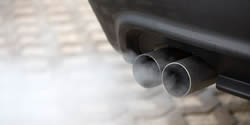
07 Jul Vehicle Exhaust
DID YOU KNOW
Gas appliances should be serviced annually by a qualified gas fitter to ensure they don’t release toxic gases into the home.
Vehicle exhausts emit a concoction of toxic fumes including carbon monoxide (lethal), carbon dioxide, nitrogen oxides, carbon particles, particulates, ultrafine particles (diesel), dioxins and hydrocarbons such as benzene. Several of these are known to cause cancer, exacerbate asthma and hay fever and can even trigger heart disease. This is why building biologists do not recommend a garage be attached to a home. Carbon monoxide (CO) is a colourless and odourless pollutant gas that is created from the combustion of carbon containing fuels such as petrol, gas, oil and coal. Due to its high affinity for haemoglobin, in sufficient concentrations it can cause unconsciousness and death due to oxygen starvation. Heath effects are noticeable when 2.5% of haemoglobin can be bound to carbon monoxide. 40% will almost certainly kill humans. According to a 2010 study of 30 homes in Melbourne, the elevated CO observed indoors has a diurnal pattern similar to that of domestic activity. The daily maximum that occurs indoors around 07:00 to 08:00am is due to elevated concentrations outside, presumably due to vehicle exhaust emissions (Commonwealth of Australia, 2010). Combustion events (any form of burning in the dwelling) were positively correlated with CO2, CO and PM2.5 and weakly correlated with NO2, which are all products of combustion. Indoor carbon monoxide concentrations generally correlate with outdoor levels except where combustion sources occur in buildings without adequate ventilation (Brown 1997).
54% of Victoria’s carbon monoxide emissions in ambient air come from vehicle exhaust (Herald Sun, 20/09/13)
Testing Your Home
Air testing is a complicated procedure that requires a thorough knowledge of the sources of potential gases in and around the building, an understanding of the current exposure standards, and the use of highly technical and expensive equipment. A building biologist will test your home for noxious gases and ultrafine particles and provide you with advice to reduce your exposure levels. For details, click here.
Solutions
- If the garage is attached to the house and appropriately seal any entrances that have direct entry into the home. Ideally this entry would be permanently closed.
- Do not idle the car in a garage if it is attached to the home
Want to Learn More?
Courses:
